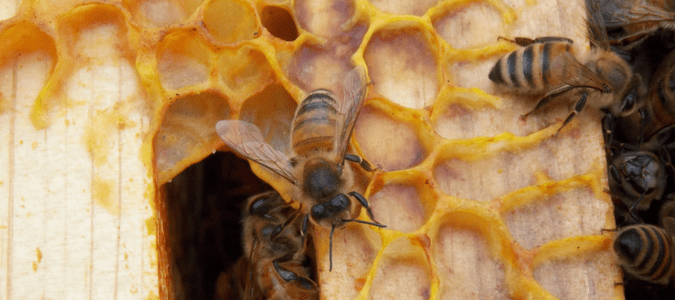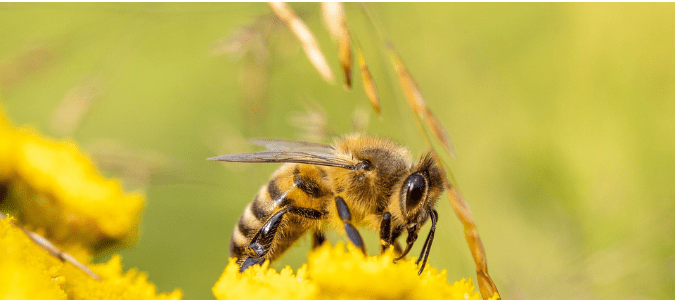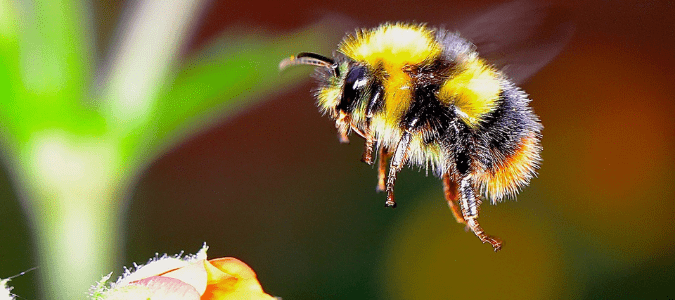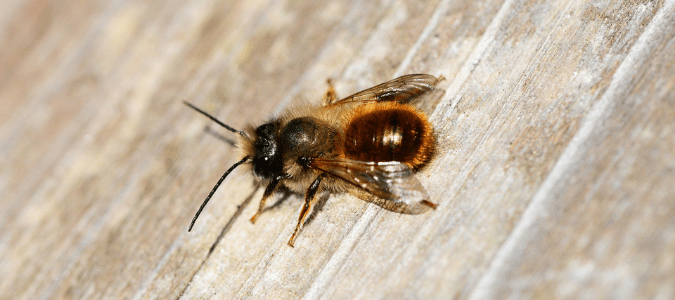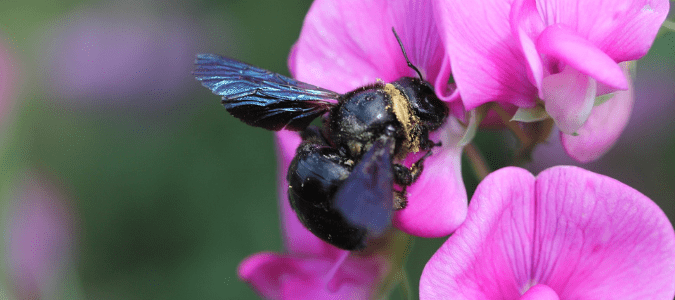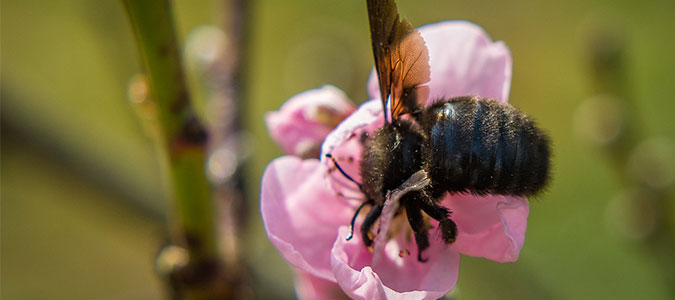Springtime in Texas is an enjoyable season to get outside and relax in your yard. But as a homeowner, you may be concerned by the presence of bees around your house. Most homeowners are surprised to learn that most bees are not dangerous for humans and play an important role in our ecosystem.
By understanding more about the different types of bees that live in Texas, you will be better prepared to keep your family safe from bee stings.
The Most Common Types of Bees in Texas
Across Texas, there are many different types of bees, including some that are native and others that migrated here. All bees may appear the same from a distance, but up close, there is huge diversity in the bee population.
Some of the most common types of bees in Texas are honey bees, bumblebees, mason bees and carpenter bees. Some of these bees prefer their time alone while others live together in a hive.
Each bee species has a unique appearance, behavior and diet. Homeowners can feel safer knowing what types of bees live around their Texas homes.
Identifying Honey Bees
Honey bees are not native to Texas, but now these common bees can be found throughout the state. Honey bees are easy to recognize with their medium-sized bodies, yellowish fuzz and black stripes.
These types of bees are social, meaning that thousands of honey bees can live together. The worker bees construct a honeycomb while the queen bee, the only fertile female in the colony, lays her eggs.
Only female honey bees can sting. When honey bees sting humans, their stingers get caught in our skin. Their bodies tear in half, causing the bee to die. Because stinging results in death, female honey bees usually only sting if their hive is in danger.
For people who are allergic to bees, a honey bee sting could be deadly. If stung, it is important to monitor symptoms and speak to an emergency health care provider immediately if you have trouble breathing.
The Behaviors of Bumble Bees
Bumble bees are native to Texas. They are bigger and hairier than honey bees. Instead of the distinct black stripes of honey bees, bumble bees have large sections of bright yellow fuzz with a small section of stripes at the base of their bodies.
Like honey bees, bumble bees carry pollen on their back legs as they fly to and from flowers. They do not create honey.
Bumble bees are social, living in hives underground. Most times, female bumble bees will not sting humans unless their nest is threatened. Unlike honey bees, bumble bees can sting multiple times because they do not die after stinging.
The Qualities of Mason Bees
Mason bees are different from bumble bees and honey bees in appearance and behavior. Mason bees have a blue, green or black color, and they are much smaller than many other types of bees in Texas.
These native bees carry pollen near their abdomens, helping plants grow and the ecosystem flourish. Because mason bees live alone, it may be more difficult for homeowners to spot them. They are most active in the spring.
Female mason bees nest in cavities they find in stone or other surfaces. As their name suggests, mason bees create their homes out of mud, dirt or other natural materials. Less defensive than honey bees or bumble bees, mason bees don’t typically sting, even though they can.
Distinguishing Carpenter Bees
Another of the major types of bees in Texas is carpenter bees. There are both large and small varieties of carpenter bees. Large carpenter bees stand out with big puffs of yellowish fuzz on their chests, while small carpenter bees are almost hairless.
Small carpenter bees nest in cavities similar to mason bees. They are most often solitary, but some can be more social in their habitats. Large carpenter bees burrow into softwood cavities, like in trees or old wooden structures.
Like other types of bees in Texas, males cannot sting humans, but male carpenter bees take an active role in keeping the nest safe. Males may angrily buzz around humans but are harmless. Female carpenter bees will not sting unless they are touched.
There are positive and negative trade-offs to having carpenter bees near your home. Homeowners do need to consider the fact that carpenter bees can cause damage to wooden structures, like your house. On the plus side, they pollinate vegetable gardens.
The Difference Between Ground Bees and Other Types of Bees
Bees that are native to Texas are crucial to the pollination process and the state’s agriculture. Being able to tell different types of bees in Texas apart helps homeowners know how to respond to the discovery of a ground bee population in a safe and environmentally friendly way.
What Are Ground Bees?
Ground bees make their nests underground. They are also called miner bees or ground-nesting bees. Ground bees are fuzzy and often have black backs. A type of bee found in Texas, ground bees are active in the spring and summer.
Because they live alone, females are queens of their own nest. Female ground bees find existing underground spaces where they can lay eggs. Ground bees often live in nests hidden under leaves. Around the entrance to such nests, you may notice a tiny pile of dirt and debris.
Ground bees are unlikely to sting you or your family. Like other types of bees, males are not able to sting. Females are typically harmless. As pollinators, ground bees are vital to the health of the Texas ecosystem and should be protected.
How to Deal with Ground Bees
If you locate a ground bee nest in your lawn, there is no need to panic. Often the best way to deal with ground bees is to leave them alone. There may be more than one ground bee nest in the same area.
Contact a pest control company that can determine what type of bees are living in your yard. Pest control experts can also decide whether you should take further action to discourage the presence of bees or if they should be left alone. Pest professionals can identify different types of bees in Texas and recommend solutions that best serve you and the environment.
Instead of trying to become a bee expert yourself, trust a professional to protect your loved ones from any potential threats. This is critical if someone in your family is allergic to bees, as a bee sting could prove fatal.
Wasp Versus Bee: Understanding the Difference
Bees and wasps can look very similar, so it is challenging for most homeowners to tell them apart. Since wasps can be aggressive, knowing the different traits of a wasp versus a bee can help prevent you or your family members from painful wasp stings.
Identifying Wasps Near Your Home
Generally, wasps are less fuzzy than bees. The main section of a wasp’s hourglass-shaped body does not have hair. Wasps also exhibit brighter colors and patterns than bees. Both insects have two pairs of wings.
Wasps mostly feed on other insects. Adult wasps provide pollen to larvae to help them develop. In this way, wasps contribute to the pollination process. Because they eat other pests, wasps can be helpful to homeowners with gardens.
A yellow jacket, a particular type of wasp found in Texas, looks very similar to some bees, like honey bees and bumble bees. Paying careful attention to the coloring and shape of a wasp versus a bee can keep you safer from hurtful stings or frightening attacks.
Since they do not die after stinging a human, like honey bees, wasps can sting a person multiple times. For this reason, a large wasp population can pose a threat to your family’s health.
The Benefits of Professional Pest Control
Dealing responsibly with bees and other stinging insects like wasps is part of owning a home in Texas. It is understandable if you do not want to get close enough to an insect to decide whether it is a wasp or a bee. You may be nervous to not disturb a ground bee nest or to determine if the bees in your yard are likely to sting or not.
The best way to deal with a bee population ethically is to consult pest control experts. These professionals will be familiar with environmental guidelines in Texas that protect endangered bee species. Look for a pest control provider that has good reviews online and that communicates well with customers.
Include regular inspections for ground bee nests, wasp nests, carpenter bee damage, and honey bee hives in your lawn care schedule. A pest control expert will be able to locate wasp nests or beehives and deal with them appropriately.
ABC Can Get Rid of Your Wasp and Bee Issues
Seeing bees or a wasp nest on your property can be frightening. Instead of trying to handle the bee problem on your own, contact ABC Home & Commercial Services. Our pest control professionals can effectively remove these pests, so you don’t have to worry about painful stings.
